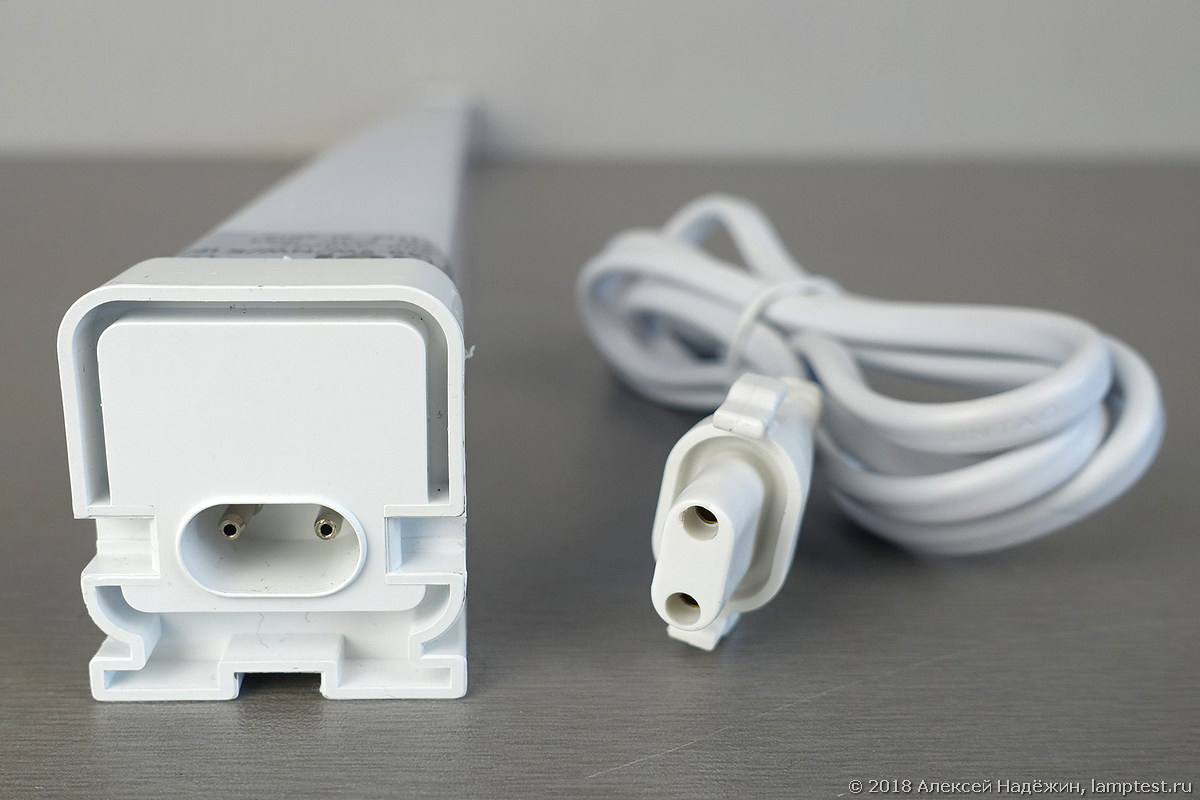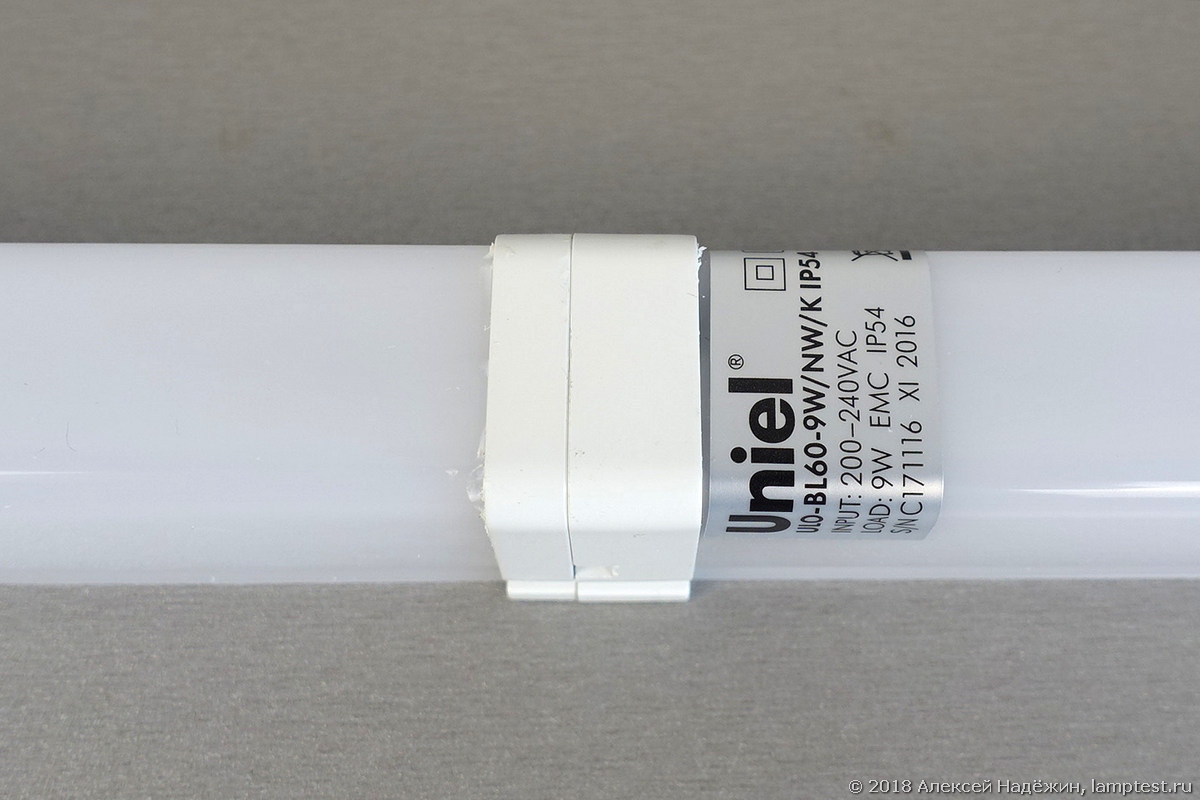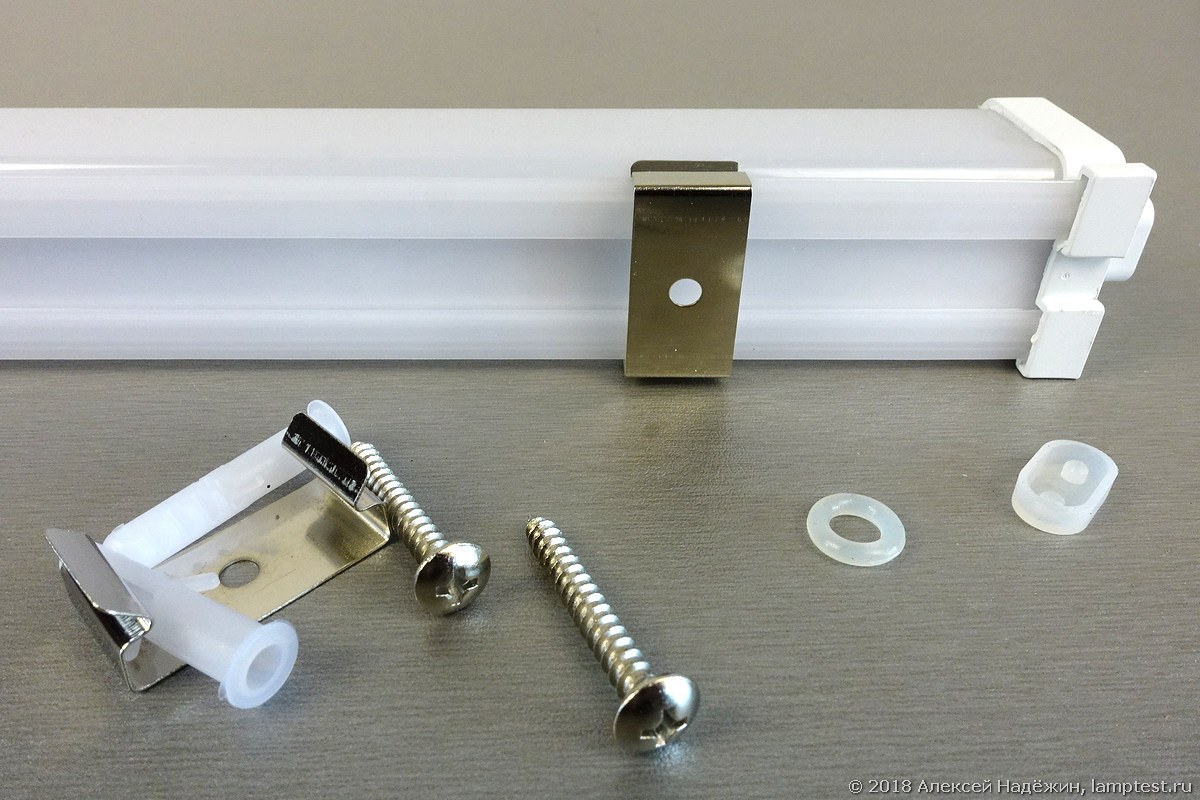Luminaire for furniture, kitchen or bathroom
In the project Lamptest.ru I have already tested more than two thousand LED lamps, but LED lighting is not only retrofit lamps for standard sockets. Now there are a huge number of different LED lamps on sale, and in many cases their use is preferable to using lamps with ordinary cartridges.
To highlight the countertops in the kitchen, bathroom mirrors, and interior lighting of the furniture, it is more convenient to use linear lights that take up very little space. Uniel offered me to test the ULO-BL60-9W-NW-K IP54 WHITE lamp, which costs only 398 rubles.

The lamp has dimensions 603x36x32 mm and weighs only 114 grams.
According to the parameters given by the manufacturer, it consumes 9 W, gives 900 lm (slightly less than a 100-watt incandescent lamp), has a color temperature of 4000K (neutral white light), a color rendering index of more than 80 and a ripple coefficient not exceeding 5%.
Complete with the lamp there is a wire with a fork, 1 meter long. There is no switch - the lamp is always on when voltage is applied to the plug.

The wire connects to a sealed connector.

On the other side of the luminaire there is another connector that allows the luminaires to be connected in a line.

This is the place where two luminaires are connected.

If the output connector is not used, it closes with the included lid. The lamp is mounted on the clips with latches.

The lamp has a degree of dust protection IP54, so it can be used in the bathroom and in the kitchen above the sink.
I got two copies of fixtures and I tested the parameters of both.
Luminous flux, color temperature and color rendering index were measured using a two-meter integrating sphere and a Instrument Systems CAS 140 CT spectrometer, power consumption with a GW Instek GPM-8212 instrument, pulsation with a Uprtek MK350D instrument. The minimum operating voltage at which the luminous flux decreased by no more than 10% of the nominal, was measured using a Lamptest-1 instrument and a LATP Suntek TDGC2-0.5. Before measurements to stabilize the parameters of the lamps warmed up for half an hour.

The actual luminous flux turned out to be even higher than what was declared - one copy of the lamp by 7%, the second by 11%. We can say that the lamp shines as brightly as a 95-watt incandescent lamp operating at a voltage of 220 volts.
The power consumption turned out to be a little higher than the declared one - by 0.7 W in the first instance and by 1.1 W in the second (this is not an error: in reality, the lamp giving slightly less light consumed slightly more).
Color temperature exactly corresponds to the stated.
The color rendition index is as stated. It is higher than 81, which means that the lamp can be used in residential premises.
The ripple level is significantly lower than what is stated and this is good. In the first instance of the lamp it was 0.1%, and in the second one it was 1%.
The luminaire can operate at reduced mains voltage. At a supply voltage of 180-240 volts, the brightness of the light remains almost unchanged. When the supply voltage drops to 160 V, the brightness drops by 10%.
The test protocol of the first copy of the lamp:

The manufacturer gives a two year warranty on the lamp. Unlike LED lamps for standard sockets, the luminaire body practically does not heat up, so it can be assumed that it will last for a long time.
© 2018, Alexey Nadyozhin
To highlight the countertops in the kitchen, bathroom mirrors, and interior lighting of the furniture, it is more convenient to use linear lights that take up very little space. Uniel offered me to test the ULO-BL60-9W-NW-K IP54 WHITE lamp, which costs only 398 rubles.

The lamp has dimensions 603x36x32 mm and weighs only 114 grams.
According to the parameters given by the manufacturer, it consumes 9 W, gives 900 lm (slightly less than a 100-watt incandescent lamp), has a color temperature of 4000K (neutral white light), a color rendering index of more than 80 and a ripple coefficient not exceeding 5%.
Complete with the lamp there is a wire with a fork, 1 meter long. There is no switch - the lamp is always on when voltage is applied to the plug.

The wire connects to a sealed connector.

On the other side of the luminaire there is another connector that allows the luminaires to be connected in a line.

This is the place where two luminaires are connected.

If the output connector is not used, it closes with the included lid. The lamp is mounted on the clips with latches.

The lamp has a degree of dust protection IP54, so it can be used in the bathroom and in the kitchen above the sink.
I got two copies of fixtures and I tested the parameters of both.
Luminous flux, color temperature and color rendering index were measured using a two-meter integrating sphere and a Instrument Systems CAS 140 CT spectrometer, power consumption with a GW Instek GPM-8212 instrument, pulsation with a Uprtek MK350D instrument. The minimum operating voltage at which the luminous flux decreased by no more than 10% of the nominal, was measured using a Lamptest-1 instrument and a LATP Suntek TDGC2-0.5. Before measurements to stabilize the parameters of the lamps warmed up for half an hour.

The actual luminous flux turned out to be even higher than what was declared - one copy of the lamp by 7%, the second by 11%. We can say that the lamp shines as brightly as a 95-watt incandescent lamp operating at a voltage of 220 volts.
The power consumption turned out to be a little higher than the declared one - by 0.7 W in the first instance and by 1.1 W in the second (this is not an error: in reality, the lamp giving slightly less light consumed slightly more).
Color temperature exactly corresponds to the stated.
The color rendition index is as stated. It is higher than 81, which means that the lamp can be used in residential premises.
The ripple level is significantly lower than what is stated and this is good. In the first instance of the lamp it was 0.1%, and in the second one it was 1%.
The luminaire can operate at reduced mains voltage. At a supply voltage of 180-240 volts, the brightness of the light remains almost unchanged. When the supply voltage drops to 160 V, the brightness drops by 10%.
The test protocol of the first copy of the lamp:

The manufacturer gives a two year warranty on the lamp. Unlike LED lamps for standard sockets, the luminaire body practically does not heat up, so it can be assumed that it will last for a long time.
© 2018, Alexey Nadyozhin
